On the margins of the good swamp
Gumbramorra Swamp and flooding in MarrickvilleOn the Margins of the Good Swamp was joint winner of the Nature Writing Prize presented by The Nature Conservancy in 2019.
Sue Castrique
I AM in the archives looking at a sketch drawn a hundred years ago of a creek. Firmly attached in the same folder are the surveyor’s completed, more formal maps. They all show a creek curling through what is now the Addison Road Community Centre in Marrickville.
If there was a creek then I had never seen it. I must have walked over it for years going to and from work completely unaware of it. Astonished, I look again. The surveyor made some testy notes complaining that after days of rain the site was a quagmire. He had poked at the mud and probably trudged through it too, and was clearly implying it was not a good place to build. Not much later a corrugated iron drill hall was constructed directly on top of the creek and the site became an army depot that sixty years later was transformed into a community centre. The creek disappeared.

Detail of a map drawn in 1848. After two years of drought the ‘Swamp’ remains. Tramvale was built on its margins, north of Swamp Road. Someone later noted in pencil ‘Swamp now Marrickville’. Old System Deeds, Book 16, no. 892. p 9. Courtesy of the Office of the Registrar General, a unit of the Department of Finance, Services and Innovation.
Outside the community centre I peer into a concrete gutter, listening for water.
Over the next months I trawl through historical maps, land documents, anything I can find for clues about the creek. There are just glimpses, but they gradually accumulate a force that says here, it was here.
The creek was one of several that came down from the surrounding uplands to feed Gumbramorra Swamp, an ephemeral wetland in Marrickville Valley. Creeks were the sinews that connected a series of waterholes, mudflats and saltmarsh in a vast wetland that emptied into Cooks River and then Botany Bay. Through the centre ran the only waterway that was named, Gumbramorra Creek, which ran almost directly north-south and was fed by three freshwater creeks from the west, another from the east, and a mesh of even smaller streams. It is difficult finding the right word to describe these fragile waterways. Dry for months of the year, they could become ferocious after rain, feeding a swamp that in wet seasons expanded across a huge open basin and in dry seasons shrank to muddy pools; it came and went.
Few other landforms could be so disappointing. In 1790 Watkin Tench was caught in the swamp. He had expected to find the ‘finest meadows in the world’, instead he was tramping through ‘high coarse rushes, growing in a rotten spongy bog, into which we were plunged knee-deep at every step.1 Europeans grumbled about the ‘slough of despair’. Yet it was also an ancient wetland where sweet water mixed with bitter water in a fresh-salty-tidal spritz that was a zone of high biodiversity and significance to the Gadigal people.
Gumbramorra Swamp figures as a kind of touchstone for many people in Marrickville. It is somewhere out there, in another historical world, just beyond our reach. It is a landscape that we sometimes speak of so clearly that people living interstate ask to see it when they visit. It is unlikely to be a tourist destination. So much of the swamp lies deep under a suburb of saw-toothed factories, asphalt and concrete gutters and cannot be seen. What lies above ground is cryptic and difficult to decipher. Yet it continues to shape the land and the way it is used in profound and unexpected ways.
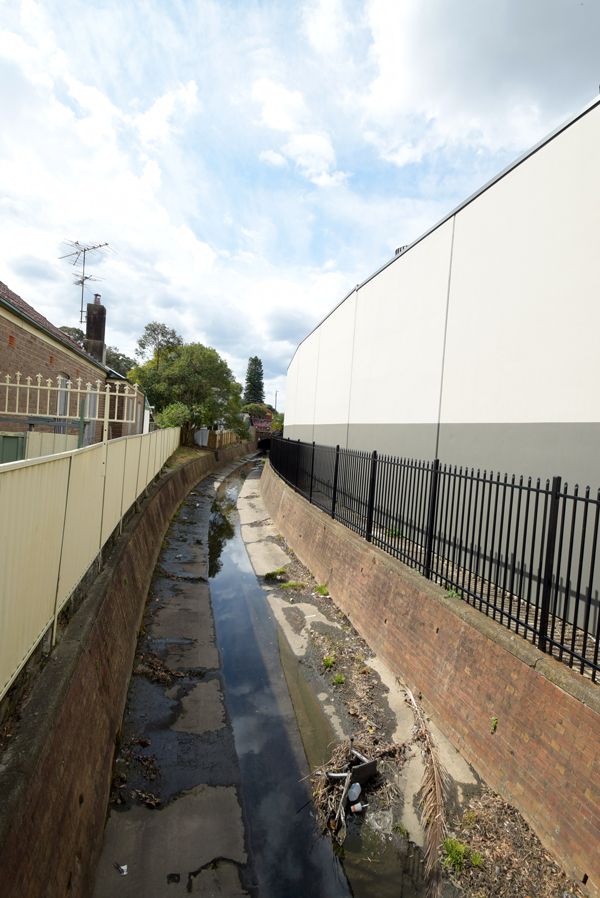
Western Stormwater Canal.
Beneath my street runs the Western Stormwater Canal, one of three concrete canals built early in the twentieth century to drain the swamp by containing the creeks and managing stormwater. The canal dives under one road and then the next, emerging each time to open air as it weaves its way to Cooks River. Today the water is turbid, but enough for a couple of ibis.
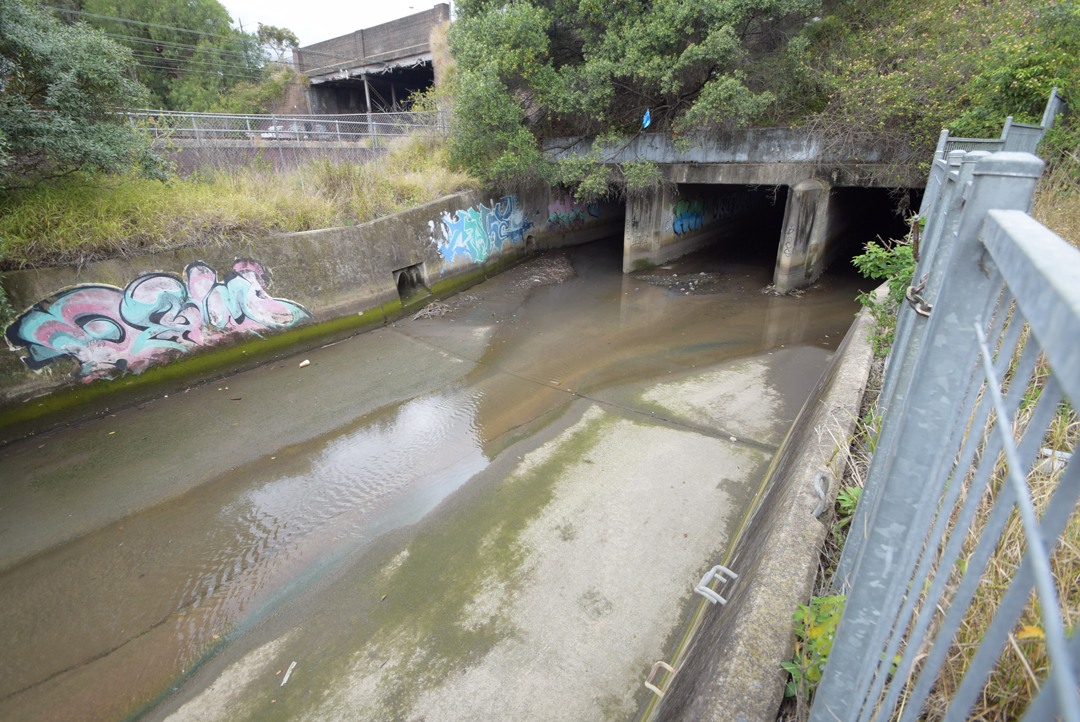
Eastern Stormwater Canal.
This canal’s twin— the Eastern Stormwater Canal—is further on, past Carrington Road and behind the factories and smash repair shops. Seeing it means clambering over car tyres, cartons and an abandoned yellow hire bike only to come up against a steel security fence. A feral cat takes off. I try another route, down the stairs from the railway bridge. It is a place I have seen John head to at the end of the day with his shopping bags. No one is entirely sure of his name—he is also called Richard—but this is possibly where he sleeps, on the strip between factory, canal and railway line, and I can see why. It is strangely secluded from the noise of the road, a forgotten part of the world.
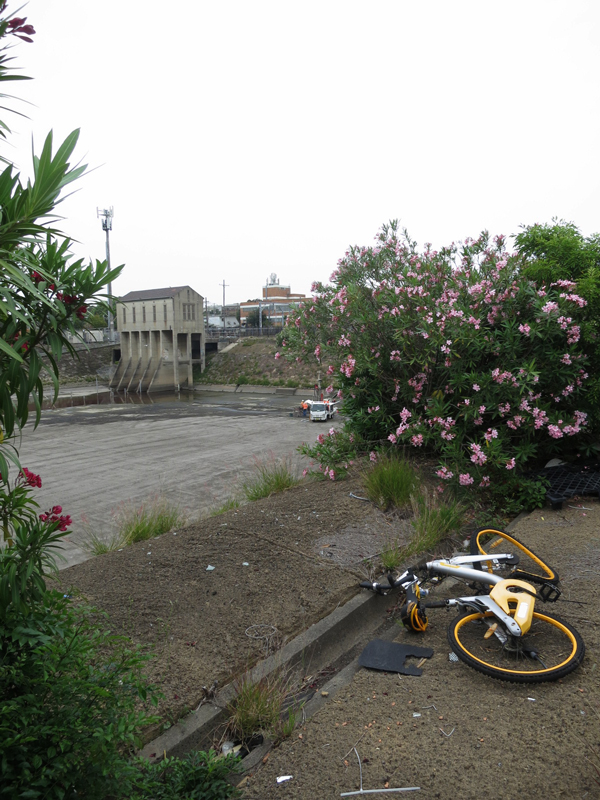
Sydenham Drainage Pit.
Even so, I am fenced off and warned off by Sydney Water: flash floods may occur at any time. It is not simply that storms cause flooding in Marrickville. The worst floods occur when a storm combines with high tide. As tidal water surges up Cooks River rainwater coming into in the valley is trapped and cannot drain away. Once that water replenished the swamp and gave it new life. Now the water floods factories, community centres and houses.
Crossing the bridge, I follow the canal alongside the railway line until it empties into Cooks River, behind another security fence. While the community centre lies at the northern edge of the swamp, this was its southern end where it splayed into saltmarsh and mangroves. It is as far as I can go. Tracking the canal beyond where I started on Carrington Road is impossible simply by walking. A goods line, suburban railway lines and a junction make it just too hard to follow. Nothing is easy about trying to make sense of Gumbramorra Swamp, but two people help me understand it a little better.
AUNTY FRAN BODKIN is a Dharawal elder and grew up in Marrickville on her mother’s traditional land. She is a botanist, environmental scientist and educator who has an intense interest in plants and climate and works to bring together Dharawal knowledge and western science. The swamp she says was a special place for the Bidigal.
We were the bitterwater peoples, the oyster eaters because we ate shellfish from the swamps. We were the swamp walkers. We drank the water from the rivers and swamps, not quite fresh water, and not quite salt water.
The valley was largely ignored by early Europeans; there were a few huts, some cleared gardens. It meant Aboriginal people continued to camp and walk through the valley and look after country. Gumbromorra Swamp provided precious resources. ‘There was so much edible stuff’, says Aunty Fran, who describes it as a supermarket for black shelled mussels, shellfish, eels and reeds with sweet tubers. The signs of river and swamp were carefully read and learned.
One thing we knew was that where the reeds grow you can drink the water, at the base of the reeds.
And when Acacia binervia burst into golden-yellow flowers it meant the mullet were running in Cooks River. Aunty Fran grew up when there were still remnants of the swamp in Marrickville, mostly near the river. She laughs about how it attracted a lot of kids.
We used the mud flats on the banks as skating rinks. It was the most beautiful mud, it was so slippery. We would run and jump on the mud and slide for metres after metres. We would come home and Mum would be at the gate with the hose.2
Chrys Meader is a local historian who was born and grew up in Marrickville, as did her father, and grandfather. She first wrote about Gumbramorra Swamp thirty years ago, and her work has captured local imagination ever since. Chrys talks about how Marrickville took shape around the swamp, split from Tempe and St Peters, which grew separately on the other side. Roads headed south to Cooks River and skirted a swamp that ‘was almost always impassable’. By the 1840s one track led west with the descriptive name of Swamp Road. In the 1860s a new and ambitious municipal council preferred the name Sydenham Road. Chrys believes European settlers avoided the swamp because ‘they did not understand its importance to local ecology. They saw it only as a source of drinking water for their cattle or useful for brick making.3
As an outsider to Sydney, I am stunned by summer rain. On a thick, humid afternoon, thunderclouds mass overhead and crack so loudly it might split the roof. Rain comes beating down, roaring down roof spouts and gutters, shaking the trees and flooding the bottom of our street. Cars trying to push through are almost submerged in the bow wave.
They call it a flash flood, as if we are surprised – but floods are almost a way of life in Marrickville. Flood management reports have been produced by Marrickville Council for decades. The most recent are dense with the new language of water managers who talk about rain events, hydrologic modelling and risk management strategies. They have also produced a multitude of maps, but one catches my eye: our high-risk flood-prone areas. It grades flood levels by depth in vivid colours that wash across the street grid. What is surprising is the pattern of flooding on this contemporary map matches the historical creeks almost perfectly.4
So is it a small question of names, have we been inundated by a flash flood? Or are we fording an ancient creek that has risen again?
If anything helped endanger Gumbramorra Swamp it was its proximity to Sydney. As historian Maria Nugent noticed: ‘cities eventually find themselves in need of their apparently useless margins.’ In 1882, the swamp was sold for housing.5
Thomas Saywell drew up the first plan for the housing subdivision of Tramvale, but sold the entire estate to a trio of Sydney businessmen: Mathias Bohrsmann, Henry French and William Shirlow – a tailor, a draper and a bootmaker who each ran thriving firms in town. Train and tram lines were pushing into the valley, triggering a land frenzy. Bohrsmann, French and Shirlow created a new subdivision more rapacious than Saywell’s. They increased the number of blocks by more than a third to 160, added laneways to the rear, made each block pocket-size and put it on the market one month later. It was housing was designed for profit. 6
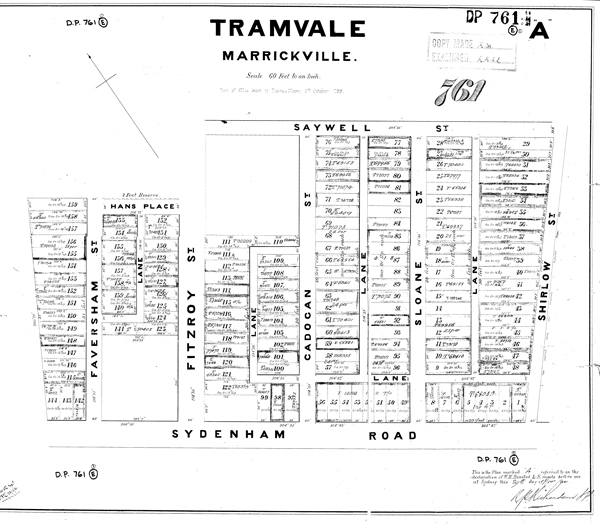
Map of Tramvale subdivision, 1882. Deposited Plan 761. Courtesy of the Office of the Registrar General.
The buyers were labourers, cab drivers, railway workers and a surprising number of women. Prices were cheap, terms were easy, and the promises brilliant. It was the very heart of the swamp, where two creeks from the west joined with Gumbramorra Creek from the north. Locals who lived nearby knew it flooded – they had seen it sheeted with water – but in 1882 it had been bone dry for three years. If buyers saw either the waterhole on one side or the creek just beyond Sydenham Road they would have seen only dry clay beds.7
As I walk down Fitzroy Road I am struck by just how difficult it is to read the lie of the land here. In a car I had never noticed the slope down to Sydenham Road, and by foot the gradient is still so gentle it barely registers. It levels out into a basin so wide and flat it is hard to believe it could retain water at all. That its flooding is connected to the tides at Botany Bay is impossible to understand simply by looking. I am not sure I would have known any better than Rose Hope, a widow from Woolloomooloo who bought lot 76 on Cadogan Street.
In 1889, after four days of torrential rain, Tramvale became a lake. The rain coincided with an exceptional tide, the highest for twenty years and water rose rapidly. Women and shivering children were rescued by boat. Attention focused mostly on Tramvale, but the flood was vast: water pooled round the railway station, then headed south through the dairies and orchards on Carrington Road to Cooks River. Water had found its way to Gumbramorra Swamp again.8
Worse, once their houses dried off they were coated in a greasy slick of sewage and tannery waste. In 1867 a huge tannery and boot factory had been built on the headwaters of Gumbramorra Creek. It drew water for the tanning pits and then dumped its waste back in the creek. Rushes grew profusely in the nutrient-rich waters, trapping a soupy mix of animal scraps and leather particles that choked the watercourse. At the same time, houses were going up in the surrounding hills of Newtown and Stanmore. Sewage flowed into the valley creating a black stinking mud that smelled ‘indescribable’. In the wet the problem was a flooding creek, in the dry a stinking creek.9
Condemnation of the Tramvale developers was almost universal. In a moment of civic pride, Saywell and Shirlow had lent their names to its streets, but now the place was a curse. Tram Vale became a moral tale, an act of folly, because buyers had been lured in a dry season to build on a swamp.
The overwhelming demand was to resume Tramvale. Fill it in. Turn it into a park. Or even better, resume the entire valley, drain it and a start again with a perfect model town with perfect sanitation. The most radical suggestion came from Reverend Thomas Roseby, a Congregational minister in Marrickville. He saw residents who had been trying only to get a roof over their head, but as steward to both a community and creation he believed the basin should be turned into a lake as nature intended. There were precedents. Roseby had lived in Ballarat and was familiar with Lake Wendouree, a natural wetland dammed during the gold rushes. But there was an even better example almost next door: Centennial Park had been created from the Lachlan Swamp only two years earlier, in 1887. ‘How easily’ said Roseby ‘the whole place might be turned into paradise’.10
As a history student at university I read Donald Meinig’s On the Margins of the Good Earth (1962), and was intoxicated by this American geographer’s examination of a landscape through time. I grew up with Adelaide’s hot gully winds; the bone-dry summers that turn the hills yellow. We were constantly reminded we were on the margins of the desert, the driest state in the driest continent. Dragging a mattress outside to sleep under the stars on a hot night was my first experience of sky and seasons, and it formed a personal measure of climate that I have never quite outlived or forgotten.
Meinig made sense of a place I knew. A series of good seasons had produced abundant wheat, and farmers were lured beyond Goyder’s Line of Rainfall to take up land the state’s surveyor general had declared too arid for reliable agriculture. Insisting that rain would follow the plough, selectors pushed into the saltbush plains.
In 1880, drought gripped South Australia and did not let up. After six years of bad seasons and failed crops, exhausted and penniless farmers abandoned their selections. The ruins of their cottages lie right across the north.11

The Bulletin’s take on selling a swamp. Tramvale was successfully inundated in 1884, 1885, 1887, 1888 and 1889. The Bulletin, 11 July 1885, courtesy of the State Library of New South Wales.
Marrickville’s problem was not drought, but floods. But here too was a struggle to come to terms with landscape and climate in a country where its cycle of boom and bust is a crucial environmental characteristic. There was no Goyder’s Line through Marrickville Valley, no demarcation of the wetland to warn the unsuspecting. New South Wales had few controls over housing subdivisions; they could be accepted or rejected only on survey grounds rather than problems with drainage or health. It was not until 1919 that local councils had any effective control at all. In South Australia farmers walked off their farms, but in the city there could be no retreat.
TRAMVALE WAS NEITHER abandoned nor resumed. At the time of the 1889 flood, there were maybe 150 residents—most lived on Sydenham Road. Away from the main road, few houses had been built at all, yet the costs of resumption were considered too high. The real problem was that government had no appetite for it, and neither did some residents, who were apparently unwilling to sell.

One Marrickville councillor hoped Tramvale would be turned into a canal and fresh fish delivered to residents for breakfast. Australian Town and Country Journal, 8 June 1889, courtesy of the State Library of New South Wales.
Despite all the noise and public argument, building quietly continued in Tramvale, and the streets filled with houses that regularly flooded. Families lived and grew up in Shirlow, Sloane and Cadogan Streets, and for the next forty years their houses were persistently flooded.
Further south was worse. Louisa Lawson, suffragist and mother of Henry Lawson, lived in a stone cottage on Renwick Street beside Gumbramorra Creek from about 1893. She had a small orchard, grew native flowers, and Henry occasionally visited. Here she celebrated her greatest achievement when women won the vote in New South Wales. But in 1897, her cottage and garden were almost certainly flooded by the creek, which inundated most of Marrickville. A newspaper reported that a woman on Renwick Street refused to leave her cottage even when the water was a metre deep—and perhaps that was Louisa. New South Wales had entered a cycle of wet seasons, and although there was a some reprieve after 1906, the entire area from Tramvale to Cooks River flooded again in 1931 and 1933.12
While government looked for a solution, the real shift involved a small matter of names. Gumbramorra Creek had been straightened and lined with sheet iron to help clean out the tannery waste and was now called the ‘Tramvale drain’. Maps that had once carefully drawn its tributaries now labelled them all ‘natural drains’. They were no longer creeks. They had become stinking ditches, the carriers of typhoid and a danger to public health. The gentle winding stream was now a public menace.13
Waterholes persisted for a moment longer. Brick pits were often located beside natural waterholes because of their clay and abundant water. One of the largest lay behind Fowler’s Pottery and was used until at least the 1940s. As brick making declined, the pits were abandoned, filled with water, and were used as swimming holes by locals who jumped the fence for a dip on a hot day. It would be wrong to suggest that every brick pit in Marrickville had been a natural waterhole, but every water body became known as a brick pit, whatever its origins. Just as the creeks become known as drains, so the waterholes were stripped of any understanding that they were part of a wetland. Names were erased and soon the ‘old swamp lands’ were no longer known as Gumbramorra.14
By the end of the nineteenth century, some mourned the creek they remembered. Frederick Gannon had lived beside Gumbramorra Creek for fifty years and remembered rowing a boat upstream almost as far as Newtown. Mary Louisa Campbell had lived with the rhythm of the waterways all her life and welcomed floods: ‘in the olden days a flood was looked upon as an advantage because it brought enrichment to the land.’ As pollution killed off fish and oysters, Aboriginal people preferred fishing in Botany Bay and rarely moved through the Cooks River Valley.15
Tramvale had been the tipping point, the moment when engineers stepped in to eliminate the swamp.
In 1898 work began on one of the biggest and most ornate pumping stations of its time. I am part of a tour group following Phil Bennett, the heritage advisor for Sydney Water who leads us through the Carrington Road pumping station. We hop over the goods line and head to the towering brick chimney used for the coal-fired steam-driven turbine. This handsome federation building with its stained glass windows and heritage tiles is a rare example, Phil tells us, one of only two stations in NSW to pump stormwater and sewage, which it once delivered to Cooks River and now sends to Malabar. The creeks connected to the pumping station are now the Central and Eastern Channels.
We pass along a walkway, over a metal grill, and a cavernous pit opens up beneath my feet that is so deep it is vertiginous. This is the very heart of the pumping station, a subterranean network of arterial drains, ventilators and cables. The valley’s creeks lie far below, whirring to the mechanical hum of an electric pump. A damp effluvial odour rises and catches the back of my throat. This is Gumbramorra Swamp, inverted.
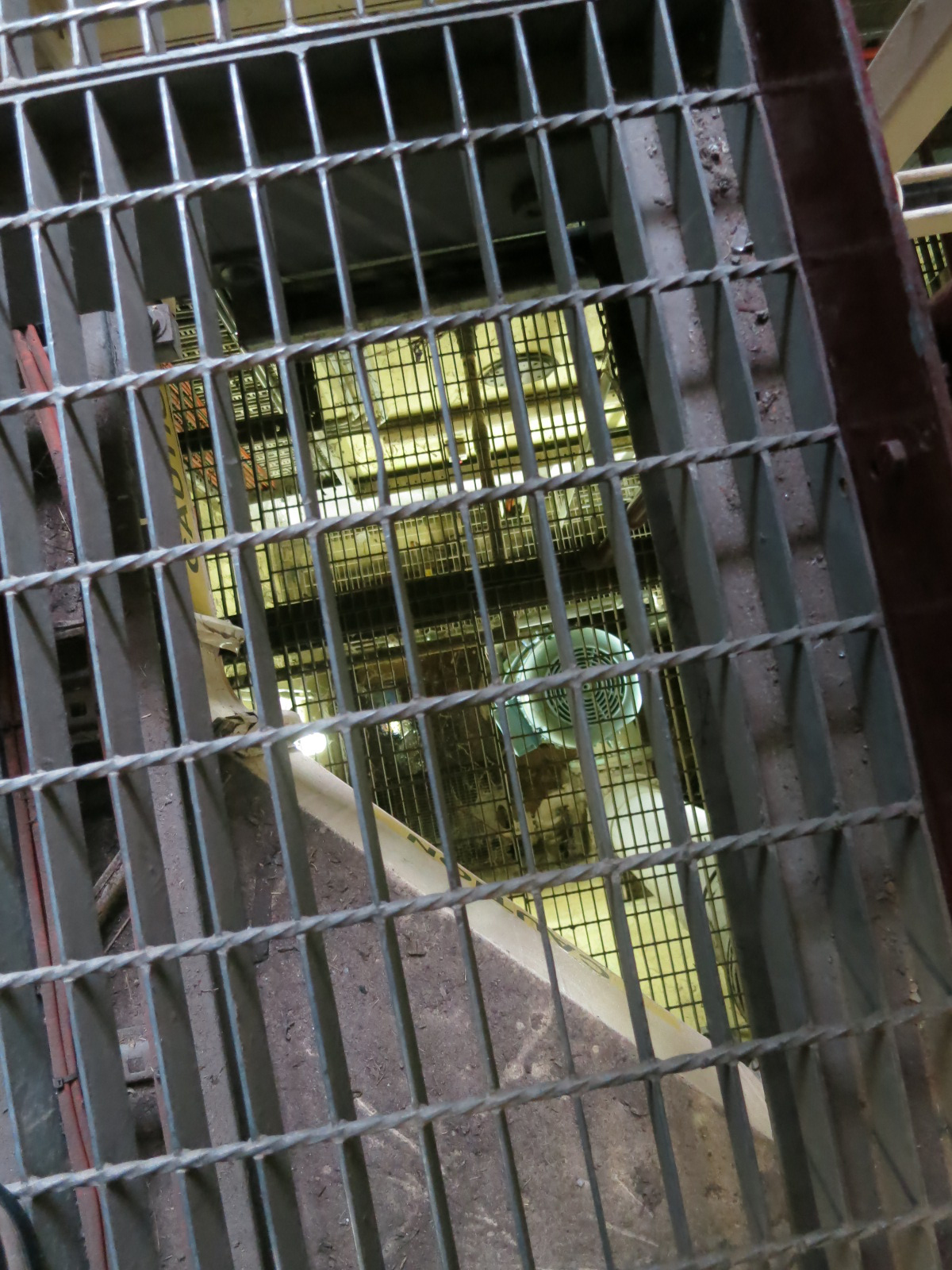
Gumbramorra swamp from Inside the Carrington Road pumping station.
It is a common story in Marrickville today that the valley was drained in the 1890s— that the problem was fixed and settled a long time ago. But draining the swamp was slow and piecemeal. Flooding continued to confound the engineers. As one creek was diverted or blocked, so flooding occurred somewhere else.
If nothing be done to stop this water . . . make Swimming pools and Football and Cricket Grounds out of them. You would get your money back off of them, it draws big crowds when it is raining so what a harvest.16
For the first time one engineer suggested that flooding might not be completely eliminated.
But the Depression provided a new impetus in relief workers who were set to work on the Sydenham Storage Pit. For so long, I had seen the pit from the train and was completely perplexed by its purpose. It is essentially a dam made from concrete and sandstone, open to the sky and with its own pumping station set on concrete fins. It was created to regulate floods by storing water, just like the waterholes that once lay behind it. The creek that curled through the Addison Road Community Centre and now known as EC1N—Eastern Channel 1 North—spills into the pit and is pumped into the Eastern Stormwater Channel and Cooks River.

Workers at the Globe Woollen Mills in the 1931 flood. Courtesy of Inner West Council Library.
I AM WALKING along Sydenham Road, the centre of a tight grid of factories that stretch to the railway line. All around is the pounding sound of industry as angle grinders bite through iron in a welding shop and fork lift trucks reverse, while somewhere above an air conditioning unit rattles an office window.
It is a strange testament to the hieroglyphics of the city that Gumbramorra Swamp is now best marked by this light industrial area. But if we peel back an archaeological layer, we find the same area was Tramvale. Houses built on the swamp gave way to factories built on the swamp.
This was no easy transformation. In 1951 the Cumberland County Council rezoned the area industrial. It was part of a master plan for Sydney, an attempt to lure people living in inner-city slums to new houses on Sydney’s outskirts. There was already a strong nucleus of industry in Marrickville, but the plan dovetailed with the hopes of a municipal council wanting to unburden itself of the shame of flooding and turn Marrickville into the Birmingham of Sydney.
With industrial rezoning, rates increased by 400 per cent. Pensioners and the poor were effectively evicted from Tramvale. Those who hung on and stayed found they were overshadowed on both sides by factories where hundreds of people worked. They may have been born and lived in Tramvale all their lives, but residents were gradually forced out, and leaving was misery.17
Small industry did the work of resuming Tramvale and took up position over the swamp. Yet a few households held on. In Chalder Avenue, I come across a house butted against a utilitarian 1960s warehouse. The bungalow has been cut in half and one side of its duplex removed to accommodate the factory, but so savagely it looks like it was ripped through by a chainsaw. Still, in the midst of all this industry someone lives here: the garden is bursting with pot plants and the roof has a new set of solar panels. The area has been found by underground artists and performers, and the illegal rave parties that spilled onto the streets at night are now housed in warehouse theatres and studios. A mural depicting Gumbramorra Swamp has been painted on the wall of a micro brewery.
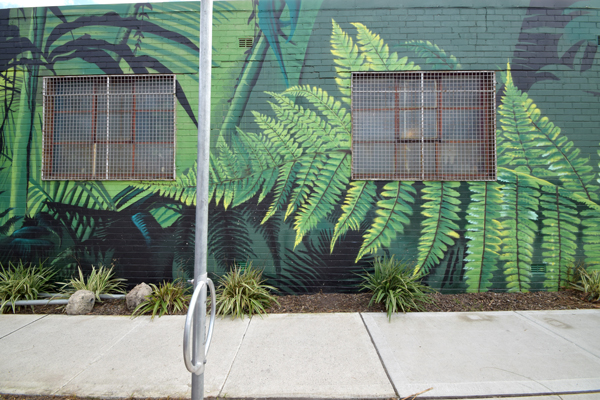
Gumbramorra Swamp re-imagined on a wall in Marrickville by Artist Dan Wenn.
As the landscape of Marrickville is remade, each time zone has stepped over the next, creating a rough unforgiving pile. Not far away, Wicks Park is a small oasis on the busy corner of Victoria and Sydenham Roads. It was the lowest part of the swamp and bordered Tramvale. In 1922 Marrickville Council resumed this small patch of land, filled it in to raise it to street level, and made into a park. The creek that ran through the park was then blocked, causing flooding in houses and factories upstream. But the park is a kind of miracle, a rare patch of open space in Marrickville.18
In local streets adjustments continue to be made to the wetland beneath our feet. Reverse Garbage is a waste-recycling centre at the community centre. It occupies the army drill hall that was built over the creek a hundred years ago. The building is sinking. Its timber floors sway and dip by almost a metre because the wooden piers it rests on are giving way into the spongy bog where the creek once flowed. The cost of repair is considerable, but until then a quarter of the Reverse Garbage building is closed.

Reverse Garbage at the Addison Road Community Centre, Marrickville
Meanwhile, at the bottom of my street on Carrington Road, developers intend to build high rise residential apartment towers that could be up to thirty-five storeys. Although Louisa Lawson’s cottage no longer exists there is no recognition of the site by developers, and the implications of 2,600 more apartments for the heritage-listed Carrington Road pumping station are unknown. The towers will stand over the southern part of Gumbramorra Swamp, which was identified in 1896 as the part which ‘suffers most from the flooding’. It is a part that will also suffer increased flooding from climate change.19

Flooding in 2012 on the corner of Renwick Street and Carrington Road. Louisa Lawson’s cottage was just a few hundred metres away. Photograph by Ben Rushton. Courtesy of Fairfax Syndication.
SUE BURTON is a kayaker who has navigated many rivers. She works for the Cooks River Alliance, a partnership of four councils trying to save one of the most polluted rivers in Australia. Gumbramorra Swamp was one of a number of wetlands on Cooks River that were critical in filtering water and providing a refuge for fish and waterbirds. Sue and I meet at the Community Assembly, where a group of fifteen people come together in a workship to imagine a better river.
Sue talks about how we are slowly realising the value of water. We have removed stormwater from our cities as quickly and efficiently as possible, but in the process we have lost something important. Water brings life to the landscape, enriches communities and is essential for ecology. We now have an entire infrastructure for stormwater – set in concrete – that is difficult to undo or change. But if we saw rain as an asset we might start to use water where it falls. Two-and-a-half times more rain falls in the Cooks River Valley than we use, and yet we are prepared to steal rainwater from another valley – from Warragamba – and pump it across to shower, drink and keep our gardens green. ‘If we valued rain, stormwater wouldn’t even have a name,’ says Sue.

Yana Badu Wetland, Chullora.
When Gumbrumorra Swamp became extinct, Marrickville lost one of its best assets. So when the Community Assembly is taken to the Yana Badu Wetland at Chullora, our eyes are opened. Here, the headwaters of Cooks River have been diverted into a carefully curated freshwater swamp, created by the South West Enviro Centre and Sydney Water. In the middle of a heavy industrial area, we step into a green world.
Is it possible to recover Gumbramorra Swamp? If not to retrieve the past, then to recreate it? To piece a wetland together again? To create a chain of ponds through Marrickville?
We live uneasily over the swamp: looking for the eels and the mullet, waiting for the paperbarks to flower and dangling our feet in its salty waters. We are haunted by water.
And every thunderstorm, the water remembers the way.
All photos by Sue Castrique unless otherwise specified
On the Margins of the Good Swamp was first published in Griffith Review, 2019.
References
1. Watkin Tench, A Complete account of the settlement at Port Jackson, December 1790, University of Adelaide Library, https://ebooks.adelaide.edu.au/t/tench/watkin/settlement/complete.html#chapter12, accessed 24 January 2019.
2. Frances Bodkin, Interview with the author, 13 April 2007 & 24 February 2016.
3. Richard Cashman & Chrys Meader, Marrickville: Rural outpost to inner city, Hale & Iremonger, Sydney, 1997, p 34. Chrys Meader, ‘Sydenham’, Dictionary of Sydney, 2008, http://dictionaryofsydney.org/entry/sydenham, accessed 24 January 2019.
4. Cardno, Final floodplain risk management plan, Inner West Council, 2017, Figure 5-3, p 46.
5. Maria Nugent, Botany Bay: Where histories meet, Allen & Unwin, Crows Nest, 2005, p 38.
6. NSW Land Registry Services, Certificate of title, vol 556, folios 113-118. Deposited plan 761 & 570.
7. Joëlle Gergis & Linden Ashcroft, ‘Rainfall variations in south-eastern Australia, part 2: a comparison of documentary, early instrumental and palaeoclimate records, 1788-1860’, International Journal of climatology, vol 33, 2013, p 2980.
8. Report on the proposed improvement of Cooks River, NSW Legislative Assembly, Votes & Proceedings, 1896, p 79. Daily Telegraph, 28 May 1889.
9. Report on the proposed improvement of Cooks River, 1896, pp 11-13. Evening News,7 July 1888.
10. Daily Telegraph, 30 May, 4 June 1889.
11. Donald W Meinig, On the margins of the good earth, Rigby, Adelaide, 1962.
12. NSW LRS, CT, vol 1368, folio 144. SMH, 2 June 1897.
13. Report on the proposed improvement of Cooks River, 1896, pp 11-14. Daily Telegraph, 27 July 1888.
14. ‘Brick pits, Marrickville’, nd, Inner West Council Archives, A95/21.61/445, Waterholes, 1929-42.
15. Report on the proposed improvement of Cooks River, 1896, pp 36, 46.
16. Walker, 17 February 1933, IWC Archives, A95/21.72/459, Stormwater Channels, 1929-1945.
17. William Murray, NSW Legislative Council, Hansard, 18 August 1959, pp 111-112
18. Duer, 4 August 1930 & Drawing 49, Marrickville Valley Stormwater Drainage, 1932, IWC Archives, A95/21.72/459.
19. Report on the proposed improvement of Cooks River, 1896, p 13. Cardno, Final floodplain risk management plan, 2017, pp 48-50.
